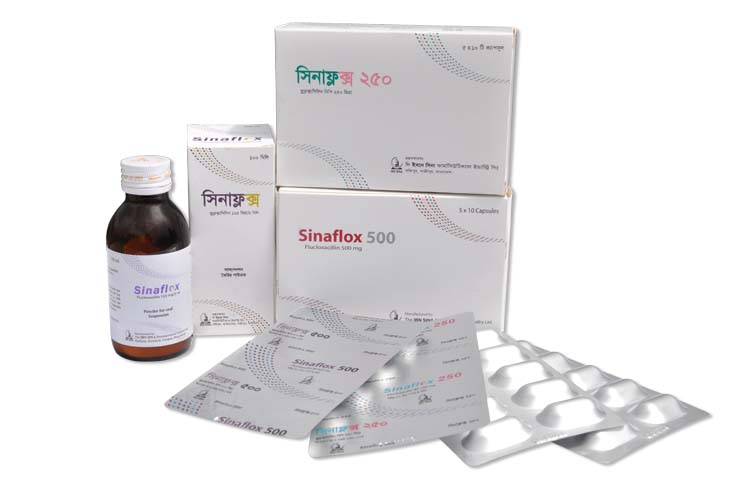
SINAFLOX
FLUCLOXACILLIN SODIUM BP
| NAME | STRENGTH | PACK SIZE | DOSAGE FORM |
|---|---|---|---|
| SINAFLOX 100 ML POS | 125 MG/ 5 ML | 100 ML | POS |
| SINAFLOX 250 MG CAPSULE | 250 MG | 48 S | CAPSULE |
| SINAFLOX 500 MG CAPSULE | 500 MG | 48 S | CAPSULE |
Sinaflox 250 Capsule: Each capsule contains Flucloxacillin 250 mg (as Flucloxacillin sodium BP).
Sinaflox 500 Capsule: Each capsule contains Flucloxacillin 500 mg (as Flucloxacillin sodium BP).
Sinaflox dry syrup: Each 5 ml contains Flucloxacillin 125 mg (as Flucloxacillin sodium BP).
Sinaflox is a preparation of Flucloxacillin. It is active against gram-positive organisms including penicillinase producing strains.
Sinaflox is indicated for the treatment of infections due to gram-positive organisms; including infections caused by 13-lactamase producing staphylococci. Typical indications include: Skin & soft tissue infections; Boils, abscesses, carbuncles, furunculosis, cellulitis; infected skin conditions, e.g. ulcer, eczema, acne; infected wounds, infected burns, protection for skin grafts, otitis media and externa, impetigo. Respiratory tract infections: Pneumonia, lung abscess, empyema, sinusitis, pharyngitis, tonsillitis. Other Infection caused by flucloxacillin-sensitive organisms: Osteomyelitis, enteritis, endocarditis, urinary tract infection, meningitis, septicaemia. Sinaflox is also indicated for use as a prophylactic agent during major surgical procedures where appropriate; for example, cardiothoracic and orthopaedic surgery.
Oral doses should be administered half to one hour before meal.
Adults (including elderly patients): 250 mg four times daily.
In severe infections: Dosage should be doubled.
Osteomyelitis, endocarditis: Up to 8 gm daily, in divided doses 6 to 8 hourly.
In case of secondary bacterial infection in chicken pox: Sinaflox 500 mg six hourly.
Hypersensitivity to penicillins.
Flucloxacillin should be used with caution in patients with evidence of hepatic dysfunction. Caution should also be exercised in the treatment of patients with an allergic diathesis.
Side effects like other penicillins are uncommon and mainly of a mild and transitory nature. Gastrointestinal upsets (e.g., nausea, diarrhoea) and skin rashes have been reported. If a skin rash occurs, treatment should be discontinued.
The use of Flucloxacillin in pregnancy should be reserved for cases considered essential by the clinician. Use of the drug in the second and third trimesters may result in the sensitization of the fetus, During lactation, trace quantities of penicillins can be detected in breast milk.
The concurrent administration of probenecid and Flucloxacillin results in higher serum peak concentrations and prolongs the time that therapeutic concentrations of Flucloxacillin are achieved in serum. Physical incompatibility and/or loss of activity of Fluctoxacillin in solution has been reported when given with gentamycin sulphate, streptomycin sulphate, vitamin mixtures. Physical incompatibility of Flucloxacillin, up to 72 hours at 15° C and/or 30° C, was reported with atropine sulphate, benzyl penicillin, chlorpromazine, diazepam, hyoscine butyl bromide, isosorbidedinitrate, rnetociopramide, tetracycline HCI, prochlorperazine, promethazine etc.
Gastrointestinal effects such as nausea, vomiting and diarrhoea may be evident and should be treated
symptomatically. Flucloxacillin is not removed from the circulation by haemodialysis.
Store below 30° C at cool and dry place, protect from light. Keep out of reach of children.
Sinaflox 250 Capsule: Box containing 12 x 4 capsules in alu-alu blister pack.
Sinaflox 500 Capsule: Box containing 12 x 4 capsules in alu-alu blister pack.
Sinaflox Dry Syrup: Bottle containing dry powder for reconstitution to 100 ml.
